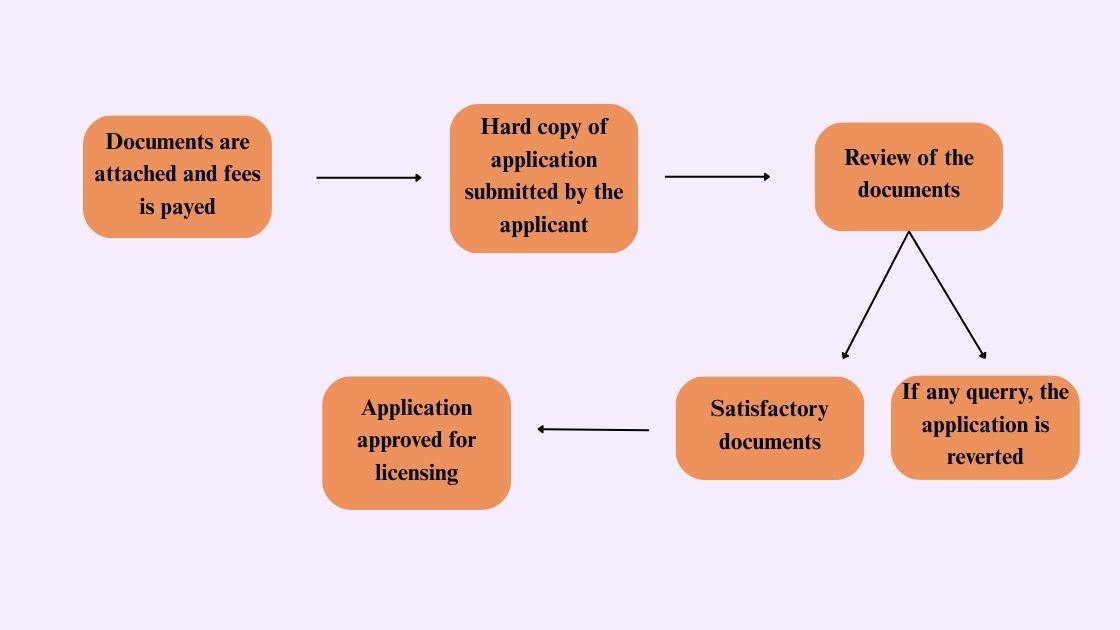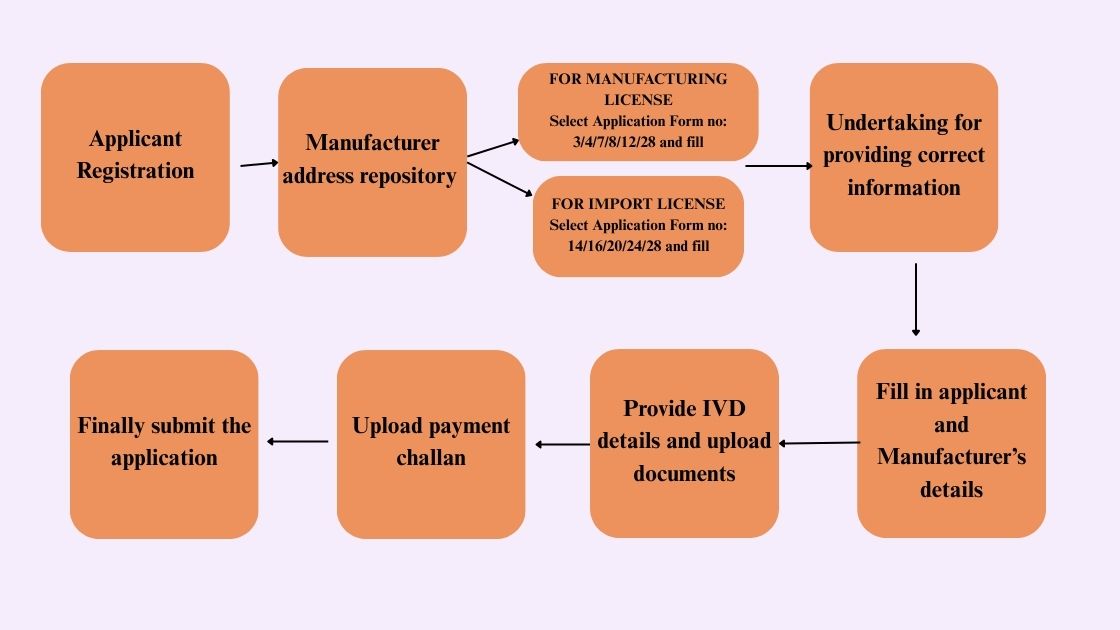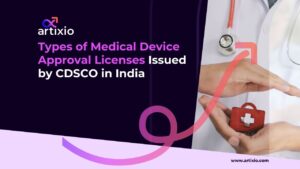IVDs in India are regulated as drugs under Section 3(b)(i) and 3(b)(iv) of the Drugs and Cosmetics Act, 1940. With the drafting of Medical Devices Rules in 2017, Medical Devices were dedicated to a specific regulatory pathway as medical devices. The IVDs were required to be classified according to the defined risk categories before being registered for marketing or import.
This blog provides an overview of the key requirements for IVD registration in India.
IVD Devices Classification In India:
According to Rule 4(2), the IVDs are classified into four categories A, B, C, and D, which are summarized below:
| Class | Description |
| Class A (Non-Sterile and Non-Measuring) | Low risk |
| Class A (Sterile or Measuring) | Low risk |
| Class B | Low to moderate risk |
| Class C | Moderate to high-risk |
| Class D | High risk |
From the risk associated with the IVD device, one can understand into which category it falls. So, to know about the classification guidance for IVDs visit the CDSCO official page, or click here to know more about the notification issued on 25 October 2023 regarding the risk-based classification.
Mandatory Requirements For IVD Devices And Test Kits In India:
Following all the key requirements for the registration of IVDs and all test kits falling in Class B, C, and D categories:
- Reference country approval proof: For imported IVDs proof from their country of origin is required such as a Certificate of Free Sale (CFS)
- ISO 13485 Certification: It depicts the international quality standards of compliance with QMS standards.
- Technical Documentation:
- DMF: The device master file (DMP) provides complete information regarding the device.
- PMF: The plant master file (PMF) provides complete information regarding the manufacturing plant of IVD.
Authorities Regulating IVDs In India:
The Central Licensing Authorities (CLA) and State Licensing Authorities (SLA) are the regulatory authorities responsible for the regulation of IVDs in India. Both regulatory authorities handle different aspects of IVD Medical Devices regulations which are described as follows:
State Licensing Authorities (SLA):
- The SLA looks over the licensing and manufacturing aspects of Class A and B IVDs.
Central Licensing Authorities (CLA):
- The CLA regulates the licensing and manufacturing aspects of Class C and D IVDs.
- It also investigates the clinical evaluation of all classes of IVDs.
- The investigations and approval procedure for non-predicate and new IVDs are also regulated by the CLA.
Role Of National Institute of Biologicals (NIB):
There are certain in vitro diagnostics and test kits that require performance evaluation reports from the National Institute of Biologicals (NIB). These tests confirm the performance, safety, and sensitivity parameters of IVD devices. These tests are required for the IVD devices and test kits related to the following conditions:
- HIV
- HBV
- Blood Grouping Reagent
- Blood Glucose Test Reagent
- Cancer
- Tuberculosis
- Malaria
- Dengue
- Chikungunya
- Syphilis
- Typhoid
- Influenza
- ToRCH (Toxoplasma gondii, Rubella virus, Cytomegalovirus, Herpes simplex virus)
- Chlamydia
- Pneumonia
- Methicillin-Resistant Staphylococcus Aureus
- Entero Virus
- Marker for a congenital disorder e.g. Screen test for Down Syndrome
- Treponema pallidum. Neisseria gonorrhoeae, Human Papilloma Virus, Herpes Virus
- Other life-threatening infections/agents
Steps For CDSCO IVD Devices Registration:
Following are the steps to be followed for CDSCO IVD registration in India:
-
- According to the first schedule, part II classify the IVDs based on the association within different class categories such as A, B, C, and D
- Then the applicant must visit the CDSCO portal with the given link
- The portal provides the registration link, where the applicant needs to register, with a valid mobile number and email ID.
- Apply for a license according to the form number applicable for your IVD manufacturing type.
- MD-3 for manufacturing license of Class A and B submitted to the SLA
- MD-4 for loan license of Class A and B submitted to the SLA
- MD-7 for manufacturing license of Class C and D submitted to the CLA
- MD-8 for loan license of Class C and D submitted to the CLA
- For importation of all classes of IVDs submit the MD-14 and MD-15 to the CLA
- Then, the applicant needs to upload the following documents:
- DMF Document
- PMF Document
- Corporate Address Proof Details
- Certificate of Incorporation
- Copy of the Wholesale License and Manufacturing License
- Undertaking Form
- Identity Proof Details
- The applicant’s details and registration details are verified by sending an OTP to the applicant’s mobile number. The applicant needs to enter the OTP on his portal
- Inspections and audits are carried out by CLA or notified bodies for Class B, C, and D.
- As per the fifth schedule, check with your system to see if it completely complies with QMS requirements.
- The CDSCO reviews your application, documents, inspection and audit reports, and quality standards compliance and may query if they find something irrelevant or missing
- Then if you comply with all the steps, CDSCO provides license and authority for IVD manufacturing.
- For non-predicate and new IVDs prior approval is required by MD-26 and MD-27 for non-predicate and MD-28 and MD-29 for new IVDs.
- If the imported IVD is approved in the USA, EU, Canada, Japan, and Australia, the IVD is exempted from clinical study requirements in India.
Approval Process For IVD Hard Copy Application:
- IVD applications can be submitted in hard copy by the applicant.
- The applicant needs to submit the documents and pay the application fees.
- The CDSCO then reviews the application and if any document is missing, the application is reverted by sending a query to the applicant.
- If the application is found satisfactory, the application is approved for licensing.
Approval Process For IVD Online Application:
- If the application for IVD is submitted through the online SUGAM portal, the applicant needs to register first on the SUGAM portal.
- Then the manufacturer’s company address is verified in the address repository.
- Then the manufacturer needs to fill in any one form from 3,4,7,8,12,28 based on his requirement for a manufacturing license.
- And for Import license any one form number from 14,16,20,24,28 should be filled in as required.
- The manufacturer’s details are required to be filled out.
- The IVD details are filled in, and documents are uploaded.
- Then the challan payment is required to be uploaded.
- And finally, the application needs to be submitted.
Stability Testing Requirements For IVDs:
According to the CDSCO, it is the responsibility of the manufacturer to ensure the IVDs’ safety and efficacy throughout their shelf life. For this specific stability, studies must be conducted under controlled conditions.
The following are the requirements for stability testing for IVDs:
Real-time and Accelerated Testing:
- This real-time testing is done over the intended shelf life under recommended storage conditions.
- Accelerated testing under stressful conditions is carried out to predict shelf life faster.
In-use Stability
- This stability test is conducted on open products to assess performance over multiple uses (e.g., open-vial stability).
Test Parameters
Various test parameters for which IVDs must be tested are:
- Sensitivity
- Specificity
- Potency
- Precision
- Appearance or integrity
Climatic Conditions
- The stability studies must reflect India’s climatic zone (e.g., Zone IVb – 30°C/75% RH).
Stability Testing Documentation Requirement:
- Protocols and methods used.
- Batch number and sample details.
- Stability data and analysis.
- Any deviations or observations?
- Final summary and shelf-life justification.
Device Master File (DMF) and Predicate Comparison for Imported IVDs
- For imported IVDs, India’s CDSCO registration process primarily involves reviewing existing approvals from reference countries.
- DMF is also required to be submitted for domestic IVDs, as part of the licensing process.
- As part of this process, manufacturers must submit a Device Master File (DMF), which is a detailed document that comprises all the technical details of the device.
- The technical details include manufacturing details, raw materials, labeling details, shelf life, etc.
- Manufacturers must submit the same documentation used abroad for IVD registration in India, while submitting the application to CDSCO, with a strong focus on predicate device comparison.
Quality System Compliance and Plant Master File (PMF) Requirements
- To meet CDSCO requirements, manufacturers must submit a Plant Master File (PMF) for each site along with valid ISO 13485 certification.
- PMF is a document that gives a detailed description of the manufacturing plant of the device.
- It gives a detailed description of the quality compliance with ISO 13485 and GMP compliance of the manufacturing plant.
- This document is also submitted along with the registration application for IVD to CDSCO.
- This document is also submitted along with the registration application for IVD by the manufacturer of Class B, C, and D IVD devices.
- Each manufacturing site requires a separate PMF, for example, if the same manufacturer has two different manufacturing sites, he must have two different PMFs.
Overview Of DMF and PMF Fee Based On The IVD Classification:
| Classification | DMF | PMF |
| Class A (Non-Sterile and Non-Measuring) | Only listing of DMF is required | N/A |
| Class A (Sterile or Measuring) | US$1000 | US$10 |
| Class B | US$1000 | US$10 |
| Class C | US$3000 | US$500 |
| Class D | US$3000 | US$500 |
October 2023 CDSCO Update For IVD Devices:
- According to the latest CDSCO update of 1st October, all Class A (Measuring/Sterile), B, C, and D devices will require MD-14/15 for their import.
- The MD-14 form should compulsory include the DMF and PMF.
- After a detailed approval process, an MD-15 import license is granted to an Indian license holder.
- And for all the non-notified class C and D IVD devices, that have their MD-14 application pending were allowed to continue their importation for the subsequent 6 months after the publication of notification of 12 October 2023.
Labeling Regulations For IVDs In India:
According to the Rule 44 of Medical Device Rules, 2017, the following aspects should be mentioned on the label of IVD:
- Name of the IVD
- Name of the manufacturer/importer
- Batch number
- Manufacture and expiry date
- Directions for use
- Storage conditions
- Special instructions (if any)
- Sterile mark (if applicable)
Unique Device Identification (UDI) Requirements For IVDs In India:
According to Rule 56 of the Medical Device Rules, 2017 applicable from January 1, 2022, all IVDs must have a Unique Device Identification (UDI).
According to the UDI requirements, the label should comprise of:
Device Identifier (DI): Specific code assigned to the product
Product identifier (PI): Serial no, batch no, expiry, lot no, etc.
Licensing Requirements And Validity For IVDs:
Following is the form number mentioned for different types of licensing requirements:
| Type Of License | Required Form For License | Purpose Of License | Regulated By |
| Manufacturing License (Class A and B) |
MD-3 and MD-5 | For IVDs manufacturing of class A and B | SLA |
| Loan license (Class A and B) |
MD-4 and MD-6 | For third-party manufacturing of IVDs of class A and B | SLA |
| Manufacturing License (Class C and D) |
MD-7 and MD-9 | For IVDs manufacturing for manufacturing of class C and D | CLA |
| Loan license (Class C and D) |
MD-8 and MD-10 | For third-party manufacturing of IVDs of class C and D | CLA |
| License to manufacture for test/evaluation/training | MD-12 and MD-13 | For testing, evaluation, and training of IVDs | CLA |
| Import license | MD-15 | For importation of all classes of IVDs | CLA |
| Import license for training, evaluation, and testing | MD-16 and MD-17 | For testing, evaluation, and training of imported IVDs | CLA |
| License to import for treatment | MD-18 and MD-19 | For the importation of IVDs for the treatment of life-threatening conditions | CLA |
Key Points To Remember While IVD Registration:
- To keep the license valid, the manufacturer/importer should renew the license every 5 years and pay the required fee within 90 days of the due date.
- Only in the case of certain non-compliance and legal issues the license is terminated.
- Before the registration of IVD, the applicant must possess an ISO 13485 certificate as proof of the product’s quality.
- It is necessary that the classification of your product is confirmed by CDSCO before you proceed towards the registration step.
Form Requirements Other Than Licensing:
| Form No | Purpose | Authority Responsible |
| MD-24 and MD-25 | Permission to conduct clinical evaluation of IVDs in India | CLA |
| MD-26 and MD-27 | For the Importation of non-predicate IVDs | CLA |
| MD-28 and MD-29 | For importation of new IVDs | CLA |
| MD-30 and MD-31 | For IVD sample testing from the CMDL lab | CLA / CMDTL |
Conclusion:
Thus, all the regulatory requirements for IVD registration are outlined under the Medical Devices Rule, 2017, governed by the CDSCO. It is important for the manufacturer and importers to comply with all the regulations to ensure smooth regulation of their IVD in India. These regulations aim to protect and safeguard public health, thus strengthening the trust of the public and promoting transparency between the regulatory authorities and stakeholders.
FAQs:
Is a test license given for manufacturing and importing an IVD?
Yes, you can apply for a test license under forms MD-12 and MD-13 for domestic devices and under forms MD-16 and MD-17 for imported devices. This license holds a validity of 3 years.
Is the appointment of an Indian Authorized Agent (IAA) mandatory for the import of IVDs?
Yes, an Indian Authorized Agent (IAA) appointment is mandatory to handle all the regulatory requirements from the CDSCO for the imported IVD in India.
Can a single IVD license be used for multiple IVDs?
No, each IVD with the same intended use requires a separate IVD license.
Can the same IVD be classified into different class categories in other countries?
Yes, each country classifies IVDs according to their designed risk-based classification.







